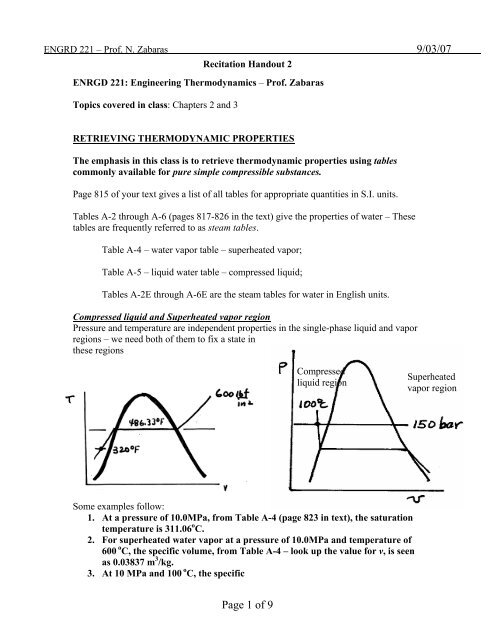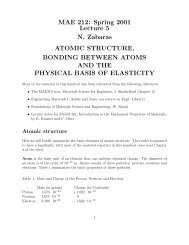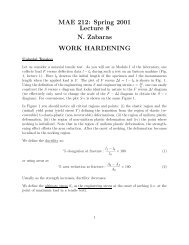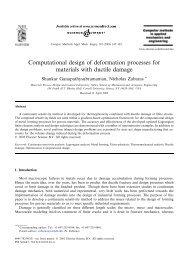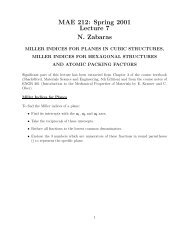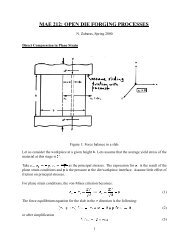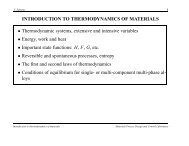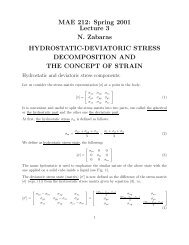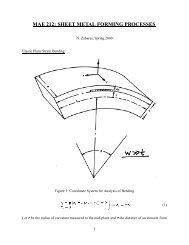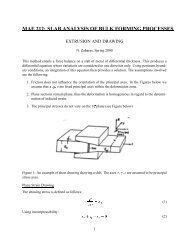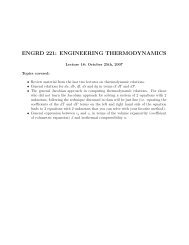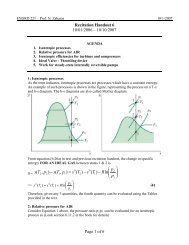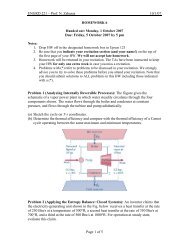Problem 1:
Problem 1:
Problem 1:
You also want an ePaper? Increase the reach of your titles
YUMPU automatically turns print PDFs into web optimized ePapers that Google loves.
ENGRD 221 – Prof. N. Zabaras 9/03/07<br />
Recitation Handout 2<br />
ENRGD 221: Engineering Thermodynamics – Prof. Zabaras<br />
Topics covered in class: Chapters 2 and 3<br />
RETRIEVING THERMODYNAMIC PROPERTIES<br />
The emphasis in this class is to retrieve thermodynamic properties using tables<br />
commonly available for pure simple compressible substances.<br />
Page 815 of your text gives a list of all tables for appropriate quantities in S.I. units.<br />
Tables A-2 through A-6 (pages 817-826 in the text) give the properties of water – These<br />
tables are frequently referred to as steam tables.<br />
Table A-4 – water vapor table – superheated vapor;<br />
Table A-5 – liquid water table – compressed liquid;<br />
Tables A-2E through A-6E are the steam tables for water in English units.<br />
Compressed liquid and Superheated vapor region<br />
Pressure and temperature are independent properties in the single-phase liquid and vapor<br />
regions – we need both of them to fix a state in<br />
these regions<br />
Compressed<br />
liquid region<br />
Superheated<br />
vapor region<br />
Some examples follow:<br />
1. At a pressure of 10.0MPa, from Table A-4 (page 823 in text), the saturation<br />
temperature is 311.06 o C.<br />
2. For superheated water vapor at a pressure of 10.0MPa and temperature of<br />
600 o C, the specific volume, from Table A-4 – look up the value for v, is seen<br />
as 0.03837 m 3 /kg.<br />
3. At 10 MPa and 100 o C, the specific<br />
Page 1 of 9
ENGRD 221 – Prof. N. Zabaras 9/03/07<br />
volume of compressed water is – from<br />
Table A-5 (page 825 in text) – 1.0385 x 10 -3 m 3 /kg. (Note that υ x 10 3 is given)<br />
Saturated liquid and vapor region<br />
The saturation tables A-2 and A-3 (pages<br />
817-820 in text) list the properties of<br />
saturated liquid and vapor states<br />
The properties are denoted by subscripts f<br />
and g to denote the fluid and gas,<br />
respectively.<br />
In the saturated liquid or vapor region, only<br />
one property is necessary to fix the state –<br />
This property is normally either the pressure<br />
or the temperature - Table A-2 is called the<br />
temperature table as the temperature is listed<br />
in the first column while Table A-3 is called<br />
the pressure table because pressures are<br />
listed in convenient increments.<br />
Compressed<br />
liquid region<br />
Saturated<br />
liquid<br />
vapor<br />
region<br />
x<br />
Superheated<br />
vapor region<br />
What is quality? Quality is the ratio of the mass of vapor to the total mass of the closed<br />
system. It is commonly denoted by x.<br />
x = m gas /(m fluid + m gas )<br />
If the quality is known, then the average specific volume of the saturated liquid – vapor<br />
mixture is calculated as<br />
v = (1-x) v f +x v g = v f + x(v g – v f )<br />
For example:<br />
Consider a system with a 2 – phase liquid-vapor mixture of water at 100 o C and a<br />
quality of 0.9. From Table A-2, page 817 in text, looking up the column with<br />
temperature=100 o C; we see that –<br />
Specific<br />
volume of<br />
liquid (v f )<br />
1.0435x10 -3<br />
m 3 /kg<br />
Specific<br />
volume of<br />
vapor (v g )<br />
Internal<br />
energy of<br />
liquid (u f )<br />
Internal<br />
energy of<br />
vapor (u g )<br />
Enthalpy<br />
of liquid<br />
(h f )<br />
Enthalpy<br />
of vapor<br />
(h f )<br />
1.673 m 3 /kg 418.94 kJ/kg 2506.5 kJ/kg 419.04 kJ/kg 2676.1 kJ/kg<br />
Therefore the specific volume of the mixture =<br />
v = v f + x(v g – v f )<br />
= 1.0435x10 -3 + 0.9*(1.673 - 1.0435x10 -3 )<br />
= 1.506 m 3 /kg<br />
Page 2 of 9
ENGRD 221 – Prof. N. Zabaras 9/03/07<br />
Similarly, the average internal energy of the mixture is<br />
u = u f + x(u g – u f )<br />
= 418.94 + 0.9*(2506.5 – 418.94)<br />
= 2297.75 kJ/kg<br />
Enthalpy is defined - in chapter 3, page 89 in text – as<br />
h = u + pv<br />
and can be evaluated for the mixture with a given quality as<br />
h = h f + x(h g – h f )<br />
= 419.04 + 0.9*(2676.1 – 419.04)<br />
= 2450.4 kJ/kg<br />
Approximation for liquids using the saturated liquid data<br />
There are methods that approximate the properties of the compressed liquids – they are<br />
easier than using the compressed liquid tables (for example the compressed water table –<br />
Table A-5).<br />
Approximate the values of v, u at a given pressure, p and temperature, T by the<br />
corresponding values of the saturated liquid at temperature T (these approximations<br />
account for the fact of little pressure dependence of v and u);<br />
v(p, T) = v f (T)<br />
u(p, T) = u f (T)<br />
The approximation of enthalpy is not the enthalpy at the saturated liquid but is a<br />
correction defined as<br />
h(p, T) = h f (T) + v f (T)*(p –p saturation )<br />
See Section 3.10.1 for more details.<br />
-----------------------------------------------------------------------------------------------------------<br />
Page 3 of 9
ENGRD 221 – Prof. N. Zabaras 9/03/07<br />
TYPICAL EXAMPLES OF POSSIBLE INPUTS AND OUTPUTS TO TABLES<br />
1. Compressed liquid and Superheated vapor region<br />
INPUT 1 INPUT 2 OUTPUT<br />
Case 1 Pressure Specific volume Temperature<br />
Case 2 Specific volume Temperature Pressure<br />
Case 3 Pressure Temperature Specific volume<br />
Most common case – Table A-4 for<br />
superheated water vapor and<br />
Table A-5 for compressed water<br />
2. Saturated liquid and vapor region<br />
INPUT OUTPUT 1 OUTPUT 2<br />
Case 1<br />
Specific volume of Pressure<br />
Temperature<br />
saturated liquid<br />
and/or vapor. Not<br />
the specific volume<br />
of the mixture<br />
Case 2 Pressure Temperature Specific volumes of<br />
the saturated liquid<br />
and vapor<br />
Case 3 Temperature Pressure Specific volumes of<br />
the saturated liquid<br />
and vapor<br />
Most common cases – Table A-3<br />
for case 2 and Table A-2 for case 3<br />
------------------------------------------------------------------------------------------------------------<br />
Note: Many of the thermodynamic tables in your text list several other properties not<br />
referred above. As we introduce these properties during the semester, you should be able<br />
to think of many other imput/output use of these tables.<br />
Page 4 of 9
ENGRD 221 – Prof. N. Zabaras 9/03/07<br />
IDEAL GAS MODEL<br />
pv = RT<br />
Ideal gas equation of state<br />
Alternative forms:<br />
pV = mRT<br />
(Substitute in v = V/m)<br />
p v =<br />
RT<br />
v = v / M<br />
R = R / M<br />
M = Molecular Weight<br />
pv = nRT<br />
v = V / n<br />
Enthalpy:<br />
h = u + pv<br />
pv = RT<br />
u = u(T)<br />
h = h(T) = u(T) + RT (Ideal Gas) (3.37)<br />
Specific Internal Energy:<br />
u depends only on temperature.<br />
c v<br />
T ) =<br />
du<br />
dT<br />
( (Ideal Gas) (3.38)<br />
uT ( ) uT ( ) c( T)<br />
dT<br />
2 1<br />
T<br />
T<br />
2<br />
− =∫<br />
(Ideal Gas)<br />
1<br />
v<br />
Specific Enthalpy:<br />
h depends only on temperature.<br />
c p<br />
T ) =<br />
dh<br />
dT<br />
( (Ideal Gas) (3.41)<br />
hT ( ) hT ( ) c ( T)<br />
dT<br />
2 1<br />
T<br />
2<br />
− =∫<br />
T<br />
1<br />
p<br />
(Ideal Gas)<br />
Page 5 of 9
ENGRD 221 – Prof. N. Zabaras 9/03/07<br />
By differentiating Eq 3.37 with respect to temperature, and plugging in Eq 3.38 & 3.41,<br />
we can obtain<br />
c<br />
( T ) = c ( T ) R<br />
(Ideal Gas) (3.44)<br />
p v<br />
+<br />
Specific heat ratio k is a function of temperature only<br />
k<br />
c<br />
p<br />
( T )<br />
= (Ideal Gas)<br />
c ( T )<br />
v<br />
Combining with Eq 3.44 results in<br />
c p (Ideal Gas)<br />
kR<br />
( T ) = k −1<br />
R<br />
( T ) = k −1<br />
c v (Ideal Gas)<br />
GENERALIZED COMPRESSIBILITY CHARTS<br />
lim<br />
p-><br />
0<br />
pv<br />
T<br />
= R<br />
(1) , where R is a common limit for all ideal gases as p->0.<br />
pv pv<br />
We define compressibility factor as, Z = RT<br />
= RT<br />
, where Z is a dimensionless ratio.<br />
Equation (1) is expressed in terms of the compressibility factor Z as lim Z = 1<br />
When the pressure of a gas is relatively small compared to the critical pressure, P c ,<br />
Z is approximately 1.<br />
When coordinates of the compressibility plots of Z with p at different T are modified,<br />
we obtain quantitatively similar plots for different gases.<br />
When Z is plotted with reduced variables, T R and p R , defined as<br />
p T<br />
pR<br />
= and TR<br />
= ,<br />
pc<br />
Tc<br />
generalized compressibility charts are obtained. Z = f(T R , p R ).<br />
p-><br />
0<br />
Figures A1 – A3 (page 911-912) in text provide generalized charts where<br />
where<br />
v′<br />
R<br />
is called the pseudo specific volume.<br />
v′ =<br />
R<br />
vpc<br />
RT<br />
c<br />
Page 6 of 9
ENGRD 221 – Prof. N. Zabaras 9/03/07<br />
Note: Absolute temperature (K) and absolute pressures should be used in<br />
compressibility charts<br />
Values of either T R or p R or<br />
known.<br />
v′<br />
R<br />
can be obtained from the plots if any two of them are<br />
Some examples computing states from the thermodynamic tables:<br />
Exercise:<br />
<br />
1. Determine the specific volume of water at a state where p = 10bar and T = 215 C.<br />
(ans. 0.2141 m<br />
3 /kg)<br />
2. Determine the temperature of water at a state of P = 0.5MPa and h= 2890 kJ / kg<br />
. (ans. 216.4 C )<br />
3<br />
3. Using the tables for water, at p = 3 bar and v = 0.5 m / kg , find T in C and u in<br />
kJ / kg . (ans. 133.6 C , 2196.7 kJ / kg )<br />
<br />
4. Using the tables for water, at p = 4 Mpa andT =160 C, find v in m 3 / kg and u in<br />
−3 3<br />
kJ / kg . (ans. 1.1011 × 10 m / kg, 673.71 kJ / kg )<br />
Page 7 of 9
ENGRD 221 – Prof. N. Zabaras 9/03/07<br />
<strong>Problem</strong> 1:<br />
• ∆U=U 2 -U 1<br />
• W tot =W pw +W piston<br />
Some hints related to the HW<br />
<strong>Problem</strong> 2:<br />
• UNITS!!! ->get everything in the same units right away!<br />
• Adiabatic!<br />
• Sign Convention<br />
<strong>Problem</strong> 3:<br />
• UNITS!<br />
W<br />
cycle<br />
• η=<br />
Q<br />
in<br />
<strong>Problem</strong> 4:<br />
• Quasi-static---equilibrium…<br />
• Yet again, unit conversion is a must<br />
<strong>Problem</strong> 5:<br />
• Use correct tables<br />
• Interpolate<br />
• Isothermal<br />
Page 8 of 9
ENGRD 221 – Prof. N. Zabaras 9/03/07<br />
<strong>Problem</strong> 6:<br />
p<br />
• pR<br />
=<br />
pc<br />
vpc<br />
• v′ R<br />
=<br />
RTc<br />
T<br />
• TR<br />
=<br />
Tc<br />
8314Nm<br />
• R=<br />
32kgK<br />
• Table A-1, fig A-2<br />
<strong>Problem</strong> 7:<br />
• C v =C p -R<br />
• A-21E get C v (T)<br />
• T2<br />
uT ( ) uT ( ) c( T)<br />
dT<br />
− =∫<br />
2 1<br />
T1<br />
<strong>Problem</strong> 8: To be discussed in class.<br />
v<br />
Page 9 of 9


